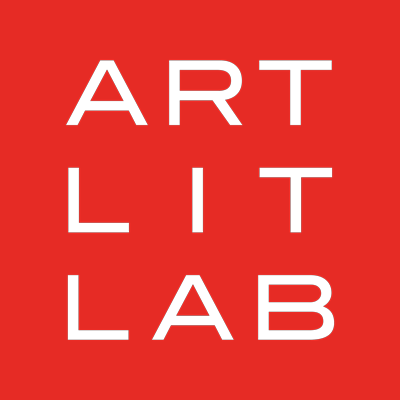In describing her inspiration for Fell Into the Honey, Ashley Lusietto’s sculptural and painting exhibition at the Arts + Literature Laboratory’s Livingston Street Gallery, the artist mentions a childhood memory of “…receiving a box of brand new dolls in the mail.” Was there joy in that moment? Delight? These may be one’s initial responses to the assemblage of quirky sculptures, with their small heads and their sometimes long-legged, often fleshy bodies.
“In my cathartic reimagining of a lingering childhood,” says Lusietto, “death becomes a catalyst for healing and preservation… Ancient honey-embalmed corpses laid to rest in tombs remain well preserved today… I use honey metaphorically— to sweeten the taste of bitter remembering and to embalm the selves of the past.”
The sculptures are constructed of plaster-bandage wrapped around paper armatures. “I love working with this material,” says Lusietto, “With it I can be gestural by pressing, squeezing, and shaping … wrapping their tiny arms and legs with thin strips of plaster was such a meditative and nurturing activity. It felt a bit like a childhood dream, like I was running a doll hospital!”
Drawing closer to the collection, we cannot miss an array of facial expressions and body-language: contentment, giddiness, vulnerability, disgust, distress. Standing at least seven-feet tall, back-center, is “Feminine Divine,” a goddess with four arms, one of which is raised—perhaps hieratically, perhaps as a gesture of authority as She marshals the menagerie extending from Her four large feet. Her open-mouthed expression suggests being caught off guard, yet ready with an answer to any question put to Her. Anchoring the collection on Her right is “Spell-Bound Kitty”, whose wide-open, yellow spiraled eyes match those of the goddess. The cat’s mouth curves downward in umbrage, a tone that seems opposite the feigned grimace on “The Sorcerer’s Apprentice,” which flanks the goddess on Her left. This figure is especially vibrant in a ruffled, flounced, off-the shoulder top and mod-plaid zubaz. Unlike the goddess, she has no apparent arms, but like the goddess, her cheeks are rouged and her black hair is gathered atop her head in a bun. Her pose suggests she has finished or is about to begin a dance.
All the figures, whether they recline or stand, seem captured after a flurry of movement. A few with wide, long-legged stances look like they are either prepping for or have transitioned from a Yoga pose.
To borrow a phrase from Yoga instructors, we might want to approach Fell Into the Honey wearing “comfortable, loose-fitting clothing,” because the remaining figures—nearly 50 of them—are more conventionally doll-sized. To appreciate the moods they convey or evoke, it helps to view them nearer to the gallery floor.
From here, we are no longer peering into a borderless playpen. Instead, we may feel as awed as the replicant Pris in Blade Runner when she enters character J.F. Sebastian’s apartment and beholds his collection of mechanized dolls. We may notice three characters are wearing tutus, one of them white with red marks, and two made of dark blue-gray voile. We may realize the dancers in the darker tutus have three eyes. That realization compels us to see the characters with more than one head.
We also see variations in how faces are made up: Some are clown-faced; some are as innocuous as Barbie dolls; many have the full eyebrows we might associate with the self-portraits of Frida Kahlo, and the eyelashes delineated luxuriantly with mascara, like that of a jazz-age vamp or Liza Minnelli’s characterization of Sally Bowles. The painted toenails on some of the characters might clue us in to the predominant variations on the lighter hues of red – salmon, coral, pink, and rose. That in turn helps us mark the departures from this color palette. A character in a lavender leotard purses her heart-shaped lips. Another with complaisant blue lips is ensconced in a peach prom dress with hints of yellow and blue. A stand-out figure in goldenrod yellow looks absolutely fierce.
We might hear echoes of dialogue or imagine vignettes. Behind “Feminine Divine” are two small figures, one is pale pink with white hair, who is reclined with a swollen foot. Her right hand is placed on her left arm like she’s holding a wad of cotton after having blood taken. She seems equally vulnerable and manipulative, perhaps telling the surly, deep pink, yellow-haired figure on her right, “I hope I’m not being a burden.”
At this level from the floor, we will likely notice a smaller version of “Feminine Divine.” Unlike the harried goddess, this incarnation is smiling; her hair is down. But she has on the same form fitting, puff-sleeved gown as the goddess, the fabric printed with vertical hashmarks, a motif repeated on maybe a dozen figures, including the coat on “Spell-Bound Kitty.” Are these non-crossed hashmarks still enumerating something? Are they marking a passage of time?
Another repeated motif, a checker-pattern, is seen in Lusietto’s paintings, also on display. A red-checkered wall is the background of the painting, “I Think I Made You Up Inside My Head.” Forefront is a distressed, sad-faced, yellow and ochre colored character reminiscent of the sculpted figures. She emerges from one of three holes in a mysterious blue surface and touches her face absentmindedly. The shadow behind her looms like a shadow-self. Beneath the blue surface, her legs are surrealistically crossed.
Lusietto says the checker pattern references her grandparents’ former home in rural Illinois where she spent the latter half of her childhood. “It’s a marker of nostalgia and the slow days of adolescence, a feeling I’ve related to very much this year. It’s also a marker of my story, a child implanted in the rural Midwest mid-childhood and raised by grandparents, the inevitable generational gap and outsider status sinking a tooth into my self-perception and confidence.”
“It’s You Who Abandoned Us” is an ironic family portrait of two adults and a child, captured in a perspective that leans the group deliberately and clumsily to the left. One of the adults smiles cluelessly; the other looks careworn and stoic; the child looks apprehensive. Here, the checkered pattern appears on the central character’s sleeveless dress.
“The paintings,” says Lusietto, “are directly inspired by the sculptures and further detail their environment, a specific place I’ve dreamt up that is a combination of a nostalgic former home, my present life in Wisconsin, and reveries fueled by longing and isolation. Being at home so much [during the pandemic] has definitely influenced the recent work .”
While many artists will acknowledge subjectivity in their work, Ashley Lusietto states plainly that her work is auto-biographical. The sometimes jarring, often enticing pieces of Fell Into The Honey reflect the power of transforming the past through creativity and courage.


